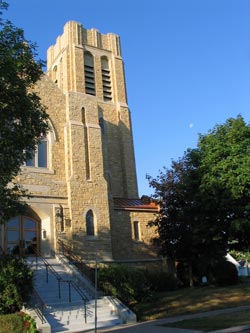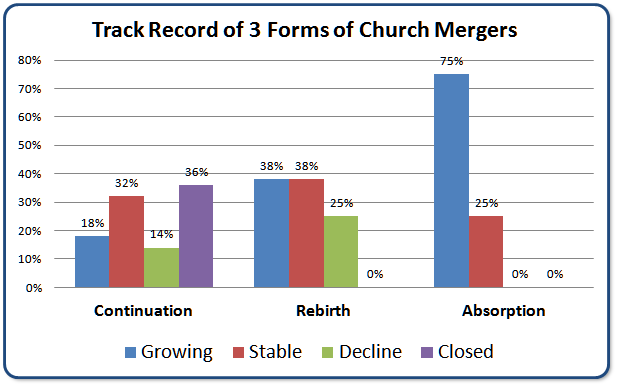Option 3: Conventional Merger
Definations of Merger or Consolidation
A merger or consolidation occurs when two or more congregations
legally join together as one. This site uses the term Conventional
Merger or Continuation Merger when the combined
congregation continues most of the traditions, programs, and
approach of the predecessor churches. Some call this a survival merger.
In a Rebirth or Restart Merger two or more churches
join together with a new name, a fresh vision and identity and, when
possible, a new or remodeled facility. A Rebirth merger or
consolidation builds the assets and strengths of the former churches
while shedding the habits and practices that keep newcomers away.
An Absorption Merger is when a smaller church joins with a
larger thriving church, sometime informally. A Multisite or
Multi-campus merger or consolidation happens when a church
that finds itself stuck and no longer attracting new people joins
with a strong growing church to become a campus of the lead church.
The words “merger” and “consolidation”
are basically synonyms—you can use the one that you prefer.
Consolidation is more accurately reflects the laws in many states
and often conforms better with denominational language and it may
feel less threatening to members who know stories of failed mergers.
Inspiring Case Study: St. Paul-Reformation, St. Paul, MN
St. Paul-Reformation Lutheran Church is the product of three
continuation mergers involving four predecessor churches. It started
in 1883 as Memorial Lutheran Church, which merged three times and
eventually became St. Paul-Reformation in 1977. During the first
decade of the 21st century it attendance almost doubled
in a community with no population growth, although the church has
faced declines since then. More information about these mergers is
at:
http://stpaulref.org/about-us/historyTrack Record of Church Mergers
There is a common saying that the result of a church merger is "1 +
1 = 1". The reality is more complex. Some merged churches end
up closing, or 1 + 1 = 0. Many find themselves in slow
decline, just like many unmerged churches. Others thrive and
end up greater than the sum of their initial parts.
The success rate of blended congregations has to be evaluated
in the context of all congregations. Since a majority of mainline
churches are now declining it should not be surprising when blended
congregations decline as well. The evaluation also has to keep in
mind the status of the churches before merger or consolidation. The
vast majority of the churches that decide to blend were struggling
at the time of the decision. One has to ask, what would be the
status of the processor churches if they hadn't combined?
A Continuation Merger usually puts congregations in a stronger
position and it often forestalls closing, but it doesn't necessarily
change the pattern of decline. See "The Life Cycle of
Congregations" on the Rebirth Merger page.
The charts below show that Rebirth Mergers have a stronger track
record than Continuation Mergers and that Absorption Mergers have
the strongest record of the three. The charts are based on an
informal 66-church sample of the almost 250 mergers and
consolidations in the ELCA between 1988 and 2008.
During the study period there apparently were no
Multisite/Multi-campus mergers or consolidations in mainline
churches. Since then there have been several, including two that
involved Dave Raymond from ChurchFuture. In evangelical churches
there have been hundreds. Early data in both mainline and
evangelical situations is encouraging. More information is at
https://churchfuture.com/church-merger-success-types-of-church-merger-shared-campus-merger
